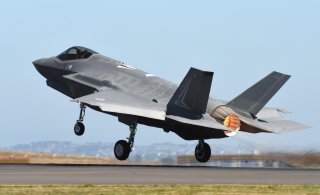Introducing the F-35 Stealth Fighter's Dirty Little Secret (That Everyone Already Knows)
The Joint Strike Fighter program is not developing one, common warplane for the U.S. Air Force, Navy and Marine Corps and the air arms of America’s closest allies.
The U.S. Senate just confirmed what an Air Force general hinted at in February 2016 — and which should have been obvious for years to close observers of U.S. air power.
(This first appeared in 2016.)
The Joint Strike Fighter program is not developing one, common warplane for the U.S. Air Force, Navy and Marine Corps and the air arms of America’s closest allies.
No, the Joint Strike Fighter is actually three different plane designs sharing a basic cockpit, engine and software and a logistical network. The Air Force’s F-35A, the Marines’ F-35B and the Navy’s F-35C should, in all fairness, be the F-35, F-36 and F-37.
“Despite aspirations for a joint aircraft, the F-35A, F-35B and F-35C are essentially three distinct aircraft, with significantly different missions and capability requirements,” the Senate stated in its version of the National Defense Authorization Act for 2017.
Before the act becomes law, the Senate must reconcile its NDAA with the House of Representative’s own version of the same bill— and Pres. Barack Obama must sign it. The F-35 language could change or disappear in coming months.
The Senate’s assertion comes just three months after U.S. Air Force lieutenant general Christopher Bogdan, head of the JSF program office, told a seminar audience that the three F-35 models are only 20- to 25-percent common, mainly in their cockpits.
(Recommended: 5 Most Deadly U.S. Warplanes)
It’s “almost like three separate production lines,” Bogdan said, according to Air Force magazine. A real joint fighter, the program boss said, is “hard” because each branch is adamant about its requirements. “You want what you want,” Bogdan said.
The Senate backs up its NDAA language by requiring Bogdan’s office to shut down in 2019, by which time the F-35 should be in full-rate production. The singular Joint Strike Fighter would break up into three separate programs — one each for the Air Force, Marines and Navy. “Devolving this program to the services will help ensure the proper alignment of responsibility and accountability the F-35 program needs and has too often lacked,” the Senate explained.
To be fair, the Navy tends to oversee most of the Marine Corps’ major weapons-acquisitions efforts. If the Senate’s proposal becomes law, the Navy could open up two new offices to manage the F-35B and F-35C. It’s unlikely the military will redesignate those JSF models as the F-36 and F-37, despite our humble recommendation that it do so.
(Recommended: The 5 Best Bombers Ever)
The Senate’s push to break up the monolithic JSF organization reflects poorly on Lockheed Martin, the prime contractor on the $400-billion program. Lockheed sold the F-35 as a “universal” stealth warplane whose different models would be highly compatible in order to simplify production, maintenance and training — and to drive down cost.
Of course, as the F-35A, F-35B and F-35C have evolved and Lockheed and the government have struggled to solve deeply-ingrained conceptual and design flaws within the program, the three models have grown in separate directions.
The multi-role F-35A is the lightest and most maneuverable of the three versions — and, at around $150 million per copy as of 2014, the — ahem — “cheapest.” Granted, that price tag is trending downward as order volume increases and Lockheed’s workers gain experience.
The $250-million, attack-optimized F-35B includes a secondary, downward-blasting engine for short and vertical takeoffs and landings — a feature that the Marines demanded and which has added significantly to the plane’s weight, complexity and cost.
The Navy’s F-35C — which the sailing branch primarily touts as a stealthy sensor-platform — possesses a bigger wing to allow for low-speed carrier landings and suffers from greater drag than the F-35A does. It cost a staggering $330 million per jet in 2014.
(Recommended: 5 Most Lethal Russian Submarines)
When the government awarded Lockheed the JSF contract back in 2001, it handed the Maryland-based plane-maker the keys to the main fighter recapitalization efforts for all three U.S. military branches that operate fast jets.
If the military and lawmakers had recognized then what they admit now — that the JSF is three different planes — the government could have awarded three separate contracts to potentially three different contractors, thus preventing the current fighter monopoly and encouraging diversity and competition within the U.S. aerospace industry.
The Pentagon alone plans to buy around 2,300 F-35s through at least the 2030s, replacing a wide range of existing planes including F-16s, F/A-18s, AV-8s and A-10s.
This piece first appeared in WarIsBoring here.


